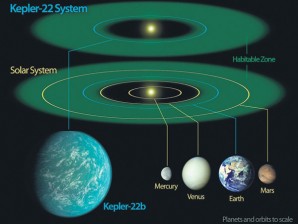NASA’s Kepler confirms 26 new planets

EARTH CONDITIONS This Nasa artist’s illustration shows Kepler-22b, a planet known to circle the habitable zone of a sun-like star. In another step toward finding Earth-like planets that may hold life, Nasa said the Kepler space telescope had confirmed its first-ever planet in a habitable zone outside our solar system. Confirmation means that astronomers have seen it crossing in front of its star three times. But it doesn’t mean that astronomers know whether life actually exists there, simply that the conditions are right. AFP
WASHINGTON—The US space agency said Thursday its Kepler space telescope mission has confirmed 26 new planets outside our solar system, all of them orbiting too close to their host stars to sustain life.
Scattered across 11 planetary systems, their temperatures would be too hot for survival, as they all circle their stars closer than Venus, the second planet from the Sun, which has a surface temperature of 464 Celsius (867 F).
But NASA scientists were still pleased with the findings, which nearly double the number of confirmed planets that Kepler has found since 2009.
“Prior to the Kepler mission, we knew of perhaps 500 exoplanets across the whole sky,” said Doug Hudgins, Kepler program scientist at NASA headquarters.
“Now, in just two years staring at a patch of sky not much bigger than your fist, Kepler has discovered more than 60 planets and more than 2,300 planet candidates,” he added.
Article continues after this advertisement“This tells us that our galaxy is positively loaded with planets of all sizes and orbits.”
Article continues after this advertisementThe discoveries are described in four different papers in the Astrophysical Journal and the Monthly Notices of the Royal Astronomical Society, NASA said in a statement.
Kepler is NASA’s first mission in search of Earth-like planets orbiting stars similar to our Sun.
It launched in March 2009, equipped with the largest camera ever sent into space — a 95-megapixel array of charge-coupled devices — and is expected to continue its science operations until at least November 2012.
In December last year, NASA announced Kepler had confirmed its first-ever planet in a habitable zone outside our solar system, Kepler 22b, though it remained unclear whether the surface was rocky or gaseous.
Such planets have the right distance from their star to support water, plus a suitable temperature and atmosphere to support life.
Spinning around its star some 600 light years away, Kepler 22b is 2.4 times the size of the Earth and orbits its Sun-like star every 290 days.
The 26 planets that Kepler confirmed on Thursday orbit their stars between every six and 143 days.